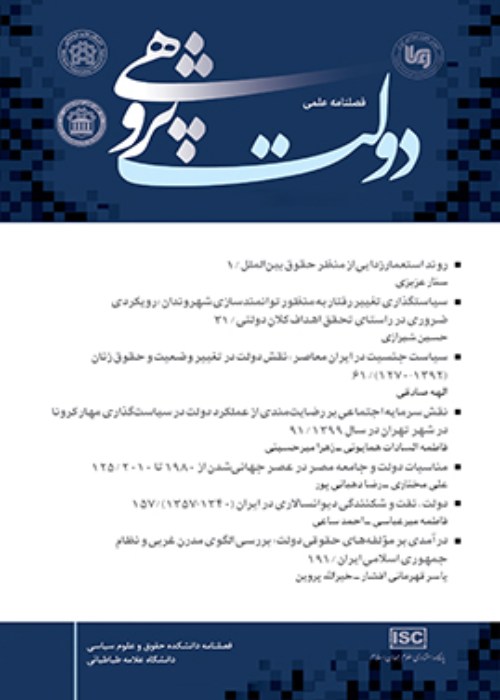Structural Analysis on the Overthrow of the Second Pahlavis
Author(s):
Abstract:
Purpose
The main goal of this article is to provide an answer to the question as to why the second Pahlavi government became vulnerable and paved the path for the Islamic revolution. Moreover, this article tries to evaluate the political behavior of the Shah with structural and state-oriented responses. The other goal is providing an analysis model for social and political scholars in order to apply it in terms of comparative studies with other cases of revolutions/quasi revolutions which are similar to sociopolitical context of Iran.Design/Methodology/Approach: The main methodological strategy of this article is qualitative approach and historical studies. In reaction to the why question of regime collapse, three structural hypotheses /answers will be mentioned which demonstrate the mechanisms through which the ancient regime became vulnerable. The first hypothesis is related to the sultanistic nature of the Pahlavi government. The second hypothesis is seeking to consider the rentier nature of government and its mechanisms which stem from beingas other reason of vulnerability. The third hypothesis presents foreign pressures and decreasing of United States supports than the Shahs government. The combination of these answers to the problem of vulnerability puts forth a relative comprehensive analysis model which can explain some aspects of states ineffectiveness in the second Pahlavi era.
Findings:The historical review of the most significant sociopolitical events during 1941-1979 shows that the Pahlavi government experienced the process of vulnerability through sultanism, rentierism and dependency to the United States. Actually, the state vulnerability on the one hand resulted from extension of the Shah despotic power, personal authority, and corruption of his relatives as well as lack of rule of law and on the other hand, depended on the autonomy of state from social classes, establishment of one party system, and extension of patronage policy. The crisis of decrease in President Carters support and his pressures in terms of human rights in Iran was the last factor which accelerated the process of vulnerability and approached the Shah into vulnerability. According to these findings, the proposed model, structurally, is capable to explain the reasons of Pahlavi regime overthrowing.
Originality/Value: With regards to the most important sociological and political sciences on the studies of Islamic Revolution in Iran, this article is taken account as a new step and insight for multi factors understanding of Pahlavi governments vulnerability. Although some scholars considered the reasons and roots of the Shahs vulnerability in light of variety of factors, the presented structural/state-oriented model and combinational hypothesis in this article can enrich the literature of sociopolitical research on Islamic Revolution studies.
Keywords:
Language:
Persian
Published:
Studies the State, Volume:1 Issue: 3, 2015
Pages:
209 to 243
https://magiran.com/p1526218
دانلود و مطالعه متن این مقاله با یکی از روشهای زیر امکان پذیر است:
اشتراک شخصی
با عضویت و پرداخت آنلاین حق اشتراک یکساله به مبلغ 1,390,000ريال میتوانید 70 عنوان مطلب دانلود کنید!
اشتراک سازمانی
به کتابخانه دانشگاه یا محل کار خود پیشنهاد کنید تا اشتراک سازمانی این پایگاه را برای دسترسی نامحدود همه کاربران به متن مطالب تهیه نمایند!
توجه!
- حق عضویت دریافتی صرف حمایت از نشریات عضو و نگهداری، تکمیل و توسعه مگیران میشود.
- پرداخت حق اشتراک و دانلود مقالات اجازه بازنشر آن در سایر رسانههای چاپی و دیجیتال را به کاربر نمیدهد.
In order to view content subscription is required
Personal subscription
Subscribe magiran.com for 70 € euros via PayPal and download 70 articles during a year.
Organization subscription
Please contact us to subscribe your university or library for unlimited access!


